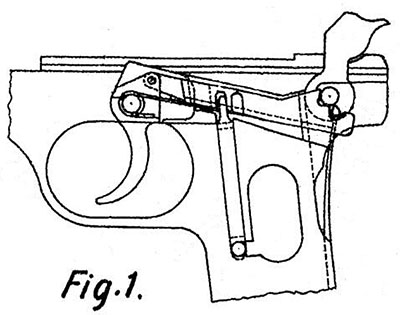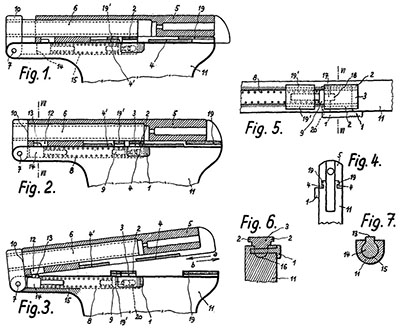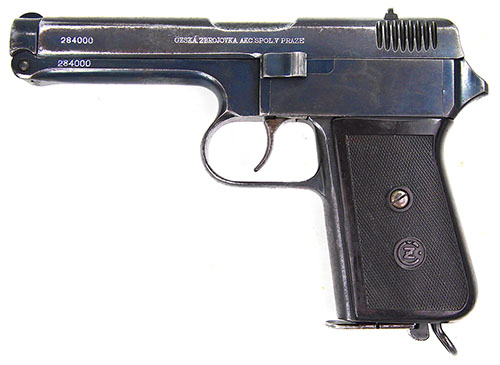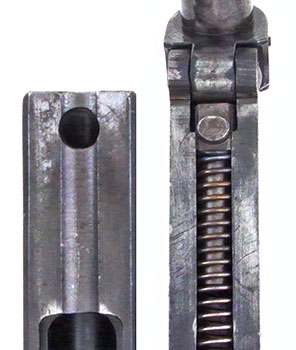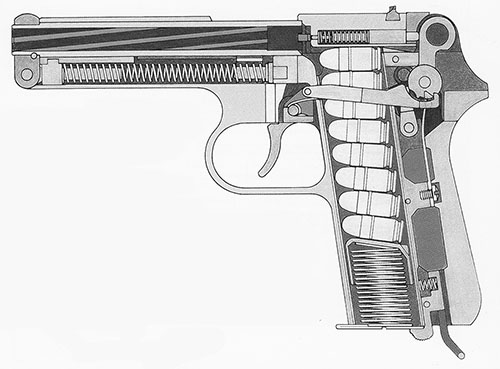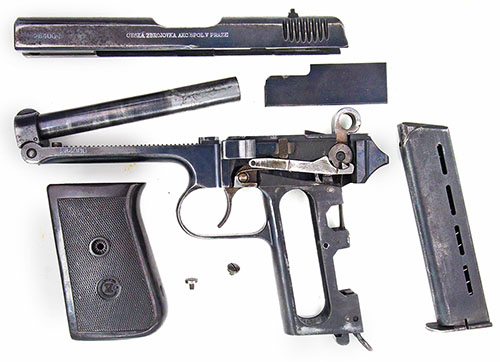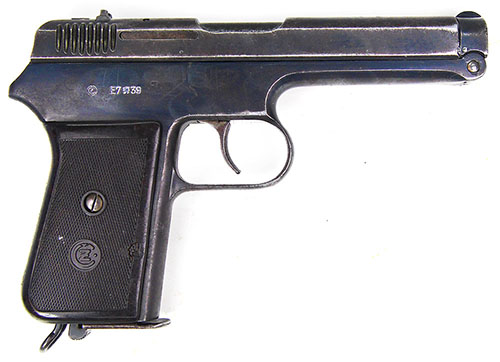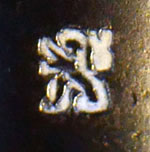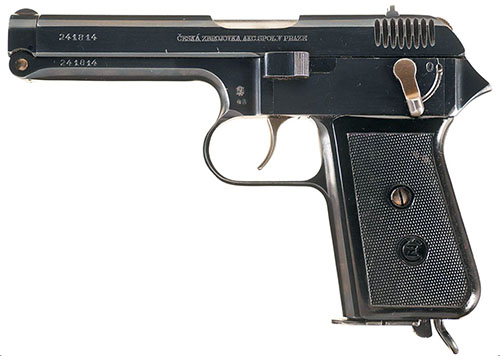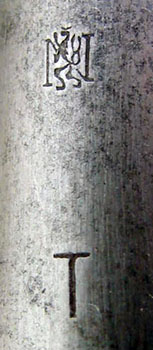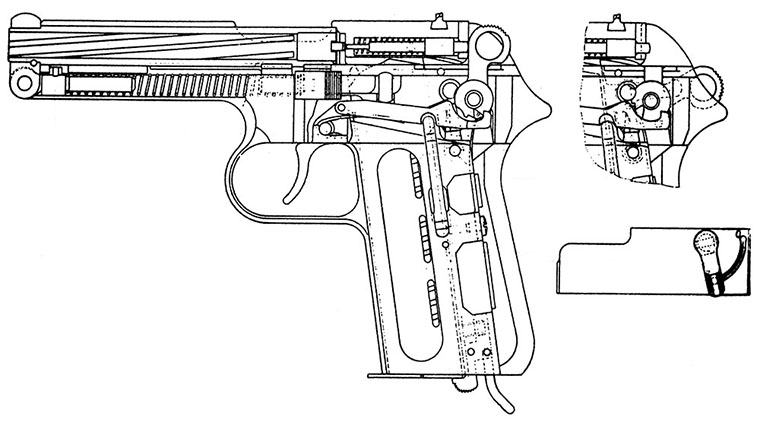 |
||||||||||||||||||||||||||||||||||||||||||||||||||||||||||||||||||||||||||||||||||||||||||||||||||||||||||||||||||||||||||||||||||||||||||||||||||||||||||||||||||||||||||||||||||||||||||||||||||||||||||||||||||||||||||||||||
|
The Czech ČZ-38 (vz.38) Pistol by Ed Buffaloe Historical Background Josef Nickl, the chief pistol design engineer for Waffenfabrik Mauser, had designed a rotary barrel pistol between 1915 and 1917, originally intended to shoot the 9mm P-08 German military cartridge. As a result of the exigencies of WWI, and subsequent restrictions placed on the German arms industry after the war, the pistol was never manufactured commercially. After the war, in 1919, the newly formed country of Czechoslovakia purchased an entire rifle factory from Mauser, and Nickl was sent to supervise the transfer and setup. He managed to interest the Czech military in his pistol, and in 1921 Czechoslovakia was granted a license to manufacture the Mauser-Nickl design. František Myška joined the Česka Zbrojovka (Czech Arms Factory) in Strakonice on 15 January 1922, where, at the age of 23, he specialized in the design of pistols. He was on the team given the job of making the vz.22 pistol into a functional military arm with interchangeable parts which eventually became the Czech vz.24. This team was led by the Russian engineer Anatoly Petrovič Zalubovskij. It is likely that Myška never met Josef Nickl, despite helping perfect Nickl’s design; Nickl left Czechoslovakia before Myška was hired. Myška subsequently simplified the vz.24 by eliminating the rotary barrel and chambering the gun for the 7.65mm Browning cartridge. This simplified design, which became known as the ČZ-27, was widely used as a police pistol in Czechoslovakia and was subsequently adopted by the German Luftwaffe in WWII. Myška worked with Karel Krnka in 1925, during his brief employment with Česka Zbrojovka, before Krnka’s death in February 1926. Myška also worked with Alois Tomiška, the designer of the Little Tom pistol, who likewise worked for Česka Zbrojovka until mid 1923. The influence of Tomiška’s Little Tom double action lockwork design can be seen in Myška’s 1928 Czech patent number 28114, which formed the basis for the ČZ-36 pistol. According to R. J. Berger: “František Myška is given credit for the design. It is, however without doubt the result of both Tomiška and Myška’s cooperation.” The same basic double action only lockwork is found in Myška’s later design for the ČZ-38 military pistol.
In 1936, the Czechoslovak military ordered 70,000 additional vz.24 pistols, but they were also seeking a simpler design that could be produced more cheaply and maintained more easily, and it seems likely that Myška was already working on such a design. His patent for the ČZ-38 was granted on 6 November 1936 as Czechoslovakian patent number 65558.
According to R. J. Berger, there is a three-quarter size double/single-action (DA/SA) 7.65mm prototype with a 1936 date and the serial number 100001; this gun may have been used to make the patent drawings. A similar but larger prototype, with a 1937 date and the serial number 300001, is chambered for the 9mm P-08 cartridge; this gun is in the collection of the Military History Institute in Prague. It is larger and heavier than the production ČZ-38, and holds nine cartridges in the magazine. According to the museum exhibit, another 9mm Parabellum prototype was made with a rotary barrel locking system and a double/single action trigger. According to Berger, a number of other early pistols are known, all dated 1937, with either double action only (DAO) or double/single action (DA/SA) mechanisms, and all with wooden grips. Berger states that twenty-five pistols (presumably DAO) were sent to twelve different military units for evaluation in January of 1938. On 14 June 1938, the Ministry of Defense placed an order for 41,000 pistols. The price per gun was less than half the cost of the ČZ-24. Germany invaded the Sudetenland (German speaking Czechoslovakia) in September 1938, but this did not immediately affect pistol production in Strakonice. According to Skramoušský, twenty test pistols (serial numbers 250042-250061) were produced in March of 1939, but only four days after their completion, on March 14th, Germany occupied the rest of Czechoslovakia. Since the factory was already tooled up, the Germans allowed the order for 41,000 pistols to be completed. They were manufactured between September and December of 1939, with serial numbers, presumably, from 250062 into the 291000 range. Further production of the ČZ-38 was halted in favor of the ČZ-27, at least until near the end of the war.
The Standard Issue ČZ-38 To quote the patent: “When the weapon is disassembled it is divided into two parts, and it is not necessary to remove any parts, such as pins, springs and the like. The weapon can therefore be disassembled safely and quickly, even by untrained persons, without the risk of losing any parts. The barrel and slide are as simple as possible, which is very advantageous for both the manufacture and the care of the weapon.” The patent covers only the design of the frame, barrel, slide, slide release, and locking block, and states specifically that the firing mechanism is not covered because it “has nothing to do with the invention.”
The ČZ-38 is an unlocked breech double action only pistol chambered for the 9x17mm Browning short (.380 ACP). The design features a barrel, the front of which is fixed in a barrel mount, which in turn pivots on a pin through the front of the frame. The recoil spring is fixed in a channel in the frame and, at the front, has a short recoil spring guide rod with an oval lug on its top. At the rear of the recoil spring is the slide locking block and plunger, which are also tensioned by the recoil spring. The bottom of the slide is closed at the front and has a round hole drilled in it. The slide slips over the barrel in such a way that, when it is pressed down, the oval lug at the front of the recoil spring guide fits into the hole in the bottom of the slide, connecting the spring and the slide. The slide release button on the left side of the frame simply pushes the slide locking block forward to allow unlocking the slide from the frame.
The ČZ-38 has the same skeletonized grip frame as the Mauser Pocket Pistol and the Czech vz. 22 and ČZ-24 pistols. The flat spring that tensions the hammer fits into a dovetail slot in the back of the grip frame, and is held in place by a screw. A small coil spring tensions the magazine release. Small coiled wire springs tension the transfer bar and the sear. The hammer is completely shrouded by the rear contour of the slide. The extractor is on the right side of the gun, flush with the slide. The ejection port is on top of the slide, and the ejector is centered on top of the frame behind the magazine.
When the one-piece grip is removed from the standard-issue ČZ-38, the sideplate can be slid down to reveal the simple double-action-only lockwork. A small bar of steel is dovetailed into the frame, behind the slide release, to serve as a positive disconnector, forcing the transfer bar down and out of alignment with the hammer when the slide is out of battery. The hammer itself turns on a pin set in the frame, and has a triangular lug on its left side to engage the transfer bar hook. A rebound notch in the base of the hammer catches on the sear, to hold the hammer off the firing pin except when the trigger is pulled. The hammer is smooth and ungrooved because it cannot, in any circumstance, be cocked. When the trigger is pulled, it pulls the transfer bar forward. The hook on the end of the transfer bar catches on the triangular hammer lug, and turns the hammer back until the hook slips off, while a lug on the inside of the transfer bar pulls the sear forward, allowing the hammer to fall on the firing pin. Due to the design of the lockwork, the trigger pull is long, heavy, and not particularly smooth; its only advantage is that it is not likely to be activated accidentally.
The front sight is part of the barrel mount. The rear sight is dovetailed into the slide and is drift adjustable. The finish is blued. Trigger, hammer, and pivot pin are heat treated to a straw color. There are eight slide serrations on each side of the slide, at the rear. The one-piece grip is checkered and has a small ČZ monogram in a circle on each side at the bottom, and two grip screws, one on either side. The magazine holds eight 9mm Browning short cartridges, and has four slots on the left side for viewing them. The magazine follower is heavy, designed to catch the slide and hold it open when the last cartridge is fired. However, the slide closes when the magazine is withdrawn.
The serial number is stamped on the left side of the frame and slide, at the front, and on the inside of the sideplate. The right side of the receiver is stamped with the ČZ monogram and the Czechoslovakian military acceptance stamp and two-digit date (E7 rampant lion 39). A very small military acceptance stamp is also found on top of the slide and barrel. The right side is marked in all-capital serif characters as follows: ČZESKÁ ZBROJOVKA AKC.SPOL.V PRAZE
According to Skramoušský, the Germans sold 1731 ČZ-38 pistols to Finland during the war. The Finnish pistols were typically stamped with an army acceptance stamp, the letters SA in a square, on the left side of the slide. This abbreviation stands for Suomen Armeija (Finnish Army). The Double/Single Action Model
According to Berger, an earlier order for 3000 pistols, possibly intended for sale to Yugoslavia or Romania (Jan Still says Romania or Bulgaria), was placed and, apparently, completed before the German invasion took place, presumably early in 1939. However, Skramoušský states that these guns were manufactured for the German Luftwaffe, and that their date of manufacture is unknown. These guns have serial numbers from 240000 to 242999. They were proofed in 1941, and received mostly commercial (rather than military) proofs, which appear on the left side of the frame, above the trigger guard, and also on the barrel. The early serial number range assigned to the guns support Berger’s implication that they were made before the war, but the 1941 proof date supports the possibility that they might have been made later, during the war. The website of the Military History Institute in Prague states: ”The reason for the development of the locked variant was the interest of the Romanian military administration, to which the armory demonstrated not only its submachine gun, but also other weapons in December 1938. Although the factory took part in the subsequently announced submachine gun competition in Bucharest in February 1939, it apparently did not have the pistol samples completed at that time.” No mention is made of when or if an order was received or completed. Apparently, factory records are incomplete or missing. According to Berger, these 240000 series guns are all DA/SA, with a manual safety lever to lock the hammer, and a magazine safety similar to the one shown in Myška’s 1928 patent for the ČZ-36, which locks the transfer bar when the magazine is removed. Berger also states that “[s]ome are are mismatched, some are missing proofs, and most all have the letter ‘T’ on the barrel...” Skramoušský states that the letter T indicates the origin of the gun as Czech, the German spelling of which is “Tschechisch.”
The DA/SA hammer has cocking grooves; the hammer rebound notch is eliminated, and a cocking notch for the single-action is added. The slide has a different, less-rounded contour at the rear to allow access to the hammer for manual cocking. A half-moon cutout for the manual safety is also found on the hammer—a safety which can only be activated with the hammer cocked. The safety lever is heat treated to a straw color like the hammer, trigger, and pivot pin.
Third Series ČZ-38 Pistols According to Skramoušský, a third series of pistols was manufactured and given serial numbers B291000 to B291999. As with the 240000 series guns, the exact date of manufacture is unknown. Berger states that few examples of these B-series guns are known, and that they exhibit a mixture of “...German and Czechoslovak commercial and military markings...,” so it is difficult to determine exactly who the guns were intended for. Skramoušský believes they were likely intended for export to Bulgaria, based on the B prefix, but further evidence is lacking. The 240000 series guns are also often referred to as “Bulgarian,” though there is no firm evidence for this. There is also an unknown number of guns with no serial number and Nazi military proofs. These may have been manufactured or assembled near the end of the war. Most have a very poor quality of finish, including some that have a phosphate finish. Nothing definitive is known about them. |
||||||||||||||||||||||||||||||||||||||||||||||||||||||||||||||||||||||||||||||||||||||||||||||||||||||||||||||||||||||||||||||||||||||||||||||||||||||||||||||||||||||||||||||||||||||||||||||||||||||||||||||||||||||||||||||||
|
||||||||||||||||||||||||||||||||||||||||||||||||||||||||||||||||||||||||||||||||||||||||||||||||||||||||||||||||||||||||||||||||||||||||||||||||||||||||||||||||||||||||||||||||||||||||||||||||||||||||||||||||||||||||||||||||
|
Copyright 2024 by Ed Buffaloe. All rights reserved. |
||||||||||||||||||||||||||||||||||||||||||||||||||||||||||||||||||||||||||||||||||||||||||||||||||||||||||||||||||||||||||||||||||||||||||||||||||||||||||||||||||||||||||||||||||||||||||||||||||||||||||||||||||||||||||||||||
|
|
||||||||||||||||||||||||||||||||||||||||||||||||||||||||||||||||||||||||||||||||||||||||||||||||||||||||||||||||||||||||||||||||||||||||||||||||||||||||||||||||||||||||||||||||||||||||||||||||||||||||||||||||||||||||||||||||
